Want a meal that’s hearty, satisfying and delightful too? Here’s it: mashed spiced vegetables; served with a side of cotton-like soft, buttery dinner rolls, crunchy onions, herby fresh coriander and tangy lemon. To sum up, Pav Bhaji is a famous street food from the ‘city of dreams,’ Mumbai. This Pav Bhaji Recipe is going to be create fireworks on your palate! Check out my step-by-step picture guide and video of making this delicious street style dish in 2 ways: one, traditionally and two, as a quick Instant Pot recipe.

What is Pav Bhaji?
Pav bhaji is an iconic dish from Mumbai which is also hugely popular as street food all over India. It first came into picture in Mumbai as a quick lunch option for textile mill workers.
Gradually, over the years, the dish became widespread. Today, you can find it as a common street food and a special in restaurants in Mumbai and the rest of India.
Just to give you the literal meaning: in Marathi, ‘pav’ means bread rolls and ‘bhaji’ refers to vegetables or a dry/gravy-style mixed veggie dish. Since this particular combination has both being served together, the dish is well-known under the sobriquet Pav Bhaji
So, you must be thinking as to what really brings in the uniqueness in the bhaji or the mix of tangy, spiced vegetables in the Pav Bhaji Recipe? It is the special spice blend called Pav Bhaji Masala that makes the difference.
It is a typical Maharashtrian spice powder which is easily available in Indian stores and online. But, with the above-linked recipe, it can be easily made at home.
This masala powder is an absolutely essential ingredient in the Pav Bhaji Recipe, as you can only achieve the most authentic and perfect flavor by using the pav bhaji masala in it.
I highly recommend including your favorite brand while making this dish. Even better if you have a batch of homemade pav bhaji masala with you.
Not to forget, just like me, if you too are a total fan of the Pav Bhaji, then you must try this savory, spiced combination called the Masala Pav—another popular street food preparation in Mumbai.
About My Recipe
Memories of my Pav Bhaji Recipe go back to the times when I was a teenager. At home, I would often make this lovely dish for my family, especially my sister, who absolutely loved to have this meal.
It was also a ritual for us to gorge on this delicious snack whenever we planned an outing to Juhu Beach in Mumbai.
The most typical way to have it was to order plates of it with a generous quantity of bhaji and 2 pavs at a time. And then, to finish the bhaji, we would keep on ordering for more pavs until there was no more bhaji left!
While I was growing up, it was almost a celebratory occasion to savor Pav Bhaji and other Mumbai-style street dishes, especially at Juhu Beach. That time with the most delectable food, wind in our hair and the sound of the gushing waves—I can never forget these!
More so, because it was the place from which I have picked up the fine tips, tricks and nuances of making this yummy recipe with a lineage of its own!
To make my version of the Pav Bhaji Recipe, specifically the bhaji, I sauté the onion, tomatoes and ginger-garlic paste in butter first. Later, I add the boiled and mashed vegetables to it, which is followed by the pav bhaji masala. Then, I simmer this gravy for some minutes and serve it steaming hot with pav, lightly toasted in butter.
The street vendors and restaurant cooks use a large, flat tawa (skillet) to make the Pav Bhaji Recipe. But when making at home, you can use a kadai (wok), skillet or frying pan.
Ingredient List
- Mixed Vegetables: I use vegetables like potatoes, capsicum, carrots, cauliflower, and green peas. The street-side versions do not have carrots and may also add less/no cauliflower. However, I add to make the bhaji more nutritious and homely.
- Green Peas: I mostly use fresh or frozen green peas, whereas dried green or white peas are used in the street side bhajis. These are cooked and mashed. This also results in a different taste and consistency of the bhaji. You can also make it with dried green peas.
- Pav Bhaji Masala: This dish will lose its essence if there is no pav bhaji masala in it. So, you can use a good-brand, ready-made pav bhaji masala or use your homemade one.
- Butter: For the bhaji, my preference has always been the Indian brand of Amul butter. But you can even use any other trusted brand or homemade butter.
- Pav: You can either buy fluffy pav or dinner rolls from a noted bakery or make a batch at home. Whenever I decide to make Pav Bhaji or Misal Pav, I usually make the Pav a day before. To make it healthier, you can choose to make whole-wheat dinner rolls.
How to make Pav Bhaji (Stepwise Photos)
Preparation
Rinse, peel and cube 3 medium or 2 larger potatoes (about 300 grams). Mine were about 1½ to 2 cups when measured. Clean 1 cup cauliflower florets (optional). Rinse ½ to ¾ cups green peas. If you want, you can also use 1 medium carrot (Half cup chopped).
For making masala, chop 1 medium onion (¾ to 1 cup chopped) , 2 medium tomatoes (¾ to 1 cup chopped), half bell pepper (½ cup chopped) and 1 green chilli. Also, make 1 tablespoon ginger-garlic paste. Keep all of these aside.
1. Add potatoes, cauliflower, peas & carrots (optional) to a pressure cooker or a pot. Pour 1½ cups water; it should be just enough to cover them partially.
2. Pressure cook for 1 to 2 whistles on a medium flame. I pressure cook for only 1 whistle.
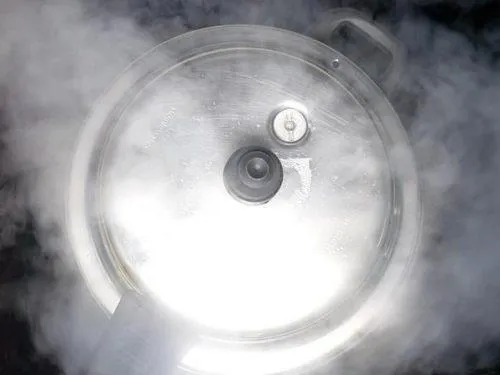
3. When the pressure releases, open the lid. Veggies should be soft-cooked. Mash them well.
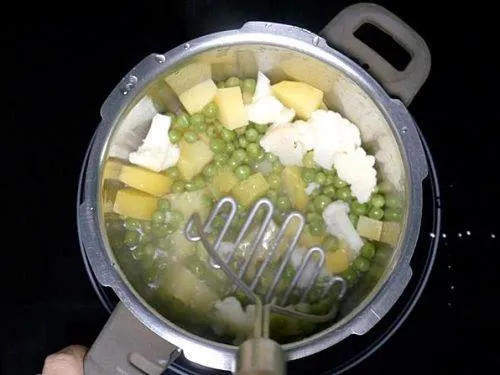
Prepare onion-tomato Tomato Masala
4. Heat 1 tablespoon butter & 1 tablespoon oil in a pan.
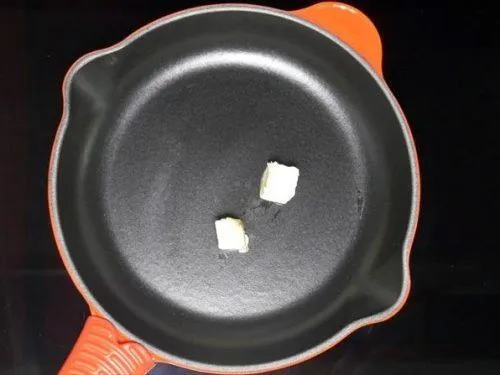
5. Add ¾ to 1 cup chopped onions. Saute till they turn translucent.
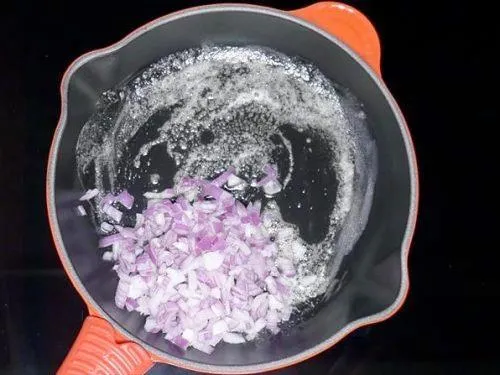
6. Add 1 tablespoon ginger-garlic paste and 1 green chilli. Fry until it smells good. Take care not to burn.
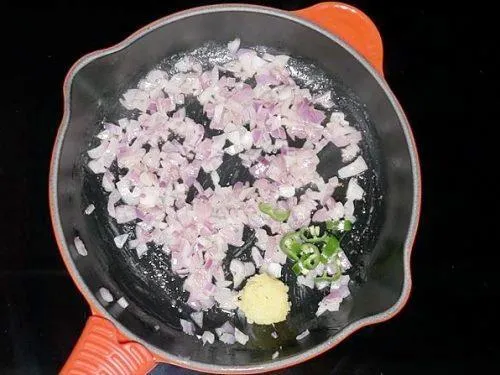
7. Add half cup chopped bell pepper. Fry for 2 to 3 minutes.
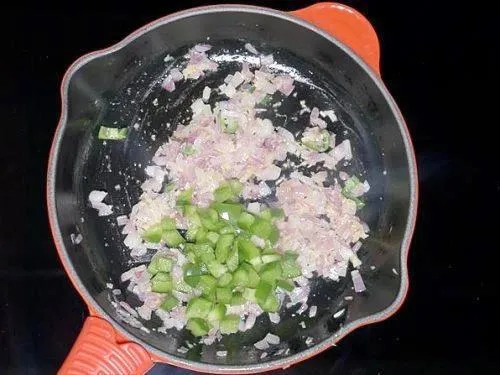
8. Add ¾ to 1 cup chopped tomatoes and 1 teaspoon salt. Fry till tomatoes turn mushy, soft and pulpy.
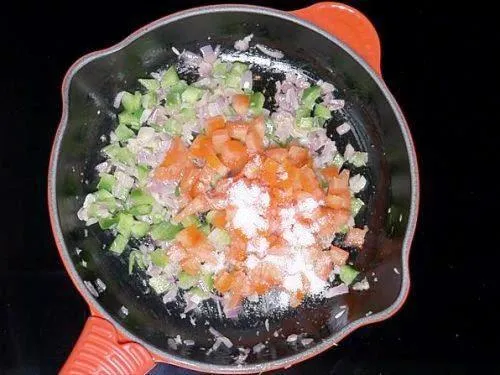
9. Add 1 teaspoon chilli powder and 1 to 1½ tablespoon paav bhaji masala powder. If making for kids, skip the chilli powder, but it will affect the color.
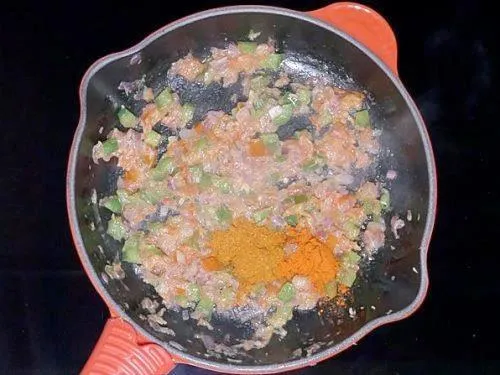
10. Mix well and fry for 2 to 3 minutes.
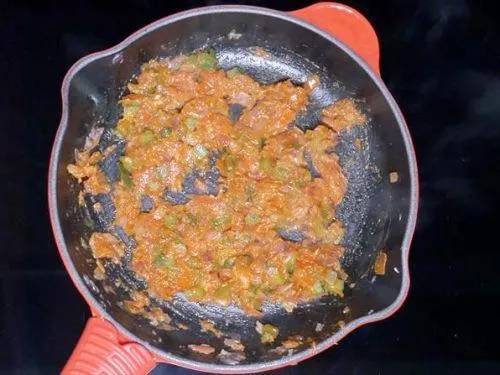
Make Bhaji
11. Add the boiled & mashed veggies. Add ½ to ¾ cups more water to bring it to a consistency.
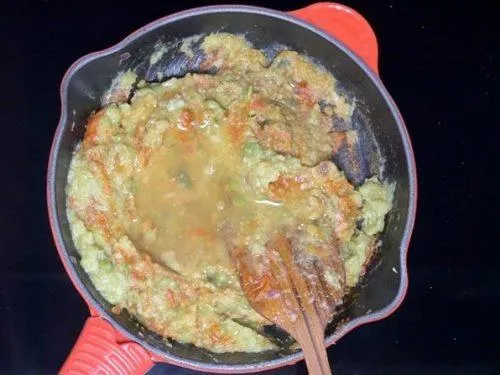
12. Mix well and simmer for a while to bring out the flavor of masala. Taste and add more salt if you want. You can also add more chili powder at this stage for brighter color. Also for more flavor, you may add more pav bhaji masala if you want.
13. Add ¾ tablespoon kasuri methi. When it reaches the desired consistency, add chopped coriander leaves. switch off. Slightly cool down and add some lemon juice before serving.
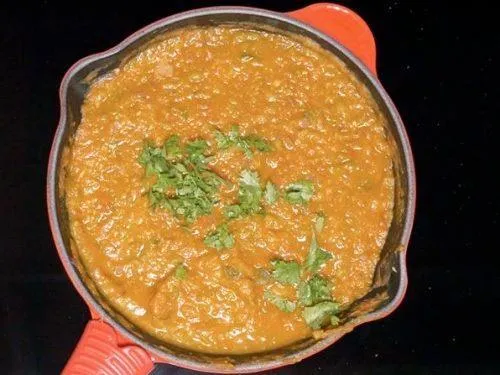
Toast Pav
14. Slit the pav horizontally, leaving one edge intact. On a low flame, heat 1 teaspoon butter on a tawa. Add little masala powder over it.
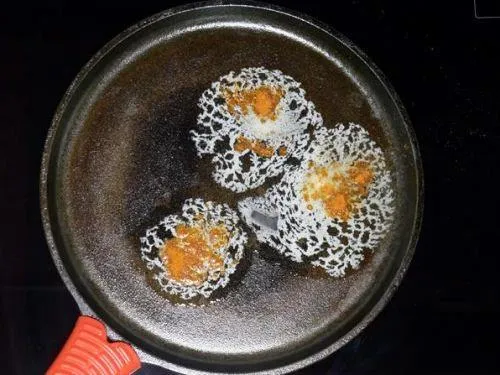
15. Place the pav on the butter and toast for 1 to 2 minutes, or until slightly crisp. Do not over do it, as the spice powder will burn. You can do the same on the other side as well by adding more butter on the pan.
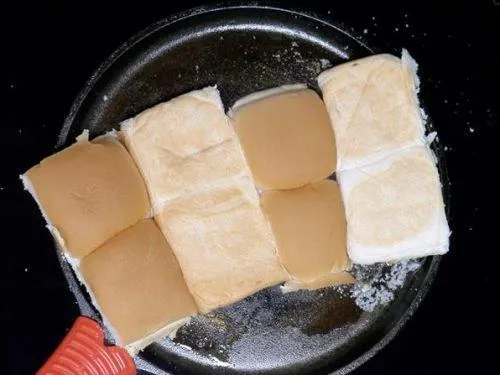
Garnish with coriander leaves, lemon wedges and chopped onions. Top with more butter on hot bhaji. Serve pav bhaji with some butter and onions.
Pav Bhaji Recipe
Pav Bhaji is a hearty, delightsome, flavorful meal of mashed vegetable gravy with fluffy soft buttery dinner rolls served with a side of crunchy piquant onions, tangy lemon and herby coriander. You will love this pav bhaji recipe for its Mumbai style flavors. I share the traditional method of making Mumbai street style Pav Bhaji recipe and a quick Instant Pot recipe

Making Bhaji
EXTRA
Accompaniments
Instructions
Instructions
Cooking Veggies
- Rinse, peel and chop the veggies. You will need 1 cup chopped cauliflower, 1 cup chopped carrot, 3 medium sized potatoes (chopped) and ⅓ cup chopped french beans. You can also add veggies of your choice.
- Add all the above chopped veggies in a 2 litre pressure cooker. Also add 1 cup green peas (fresh or frozen).
- Add 2.25 to 2.5 cups water.
- Pressure cook the veggies for 5 to 6 whistles or for about 12 minutes on medium flame.
- When the pressure settles down on its own, open the cooker and check if the veggies are cooked well. You can even steam or cook the veggies in a pan. The vegetables have be to cooked completely.
Sautéing Onions
- Heat a pan or kadai. You can also use a large tawa. Add 2 to 3 tablespoons butter. You can use amul butter or any brand of butter. Butter can be salted or unsalted.
- As soon as the butter melts, add 1 teaspoon cumin seeds.
- Let the cumin seeds crackle and change their color.
- Then add ½ cup finely chopped onions.
- Mix onions with the butter and saute on a low to medium flame till the onions translucent.
- Then add 2 teaspoons ginger-garlic paste. You can also crush 1.5 inch ginger and 5 to 6 medium garlic cloves in a mortar-pestle.
- Mix and saute till the raw aroma of both ginger and garlic goes away.
- Then add chopped green chilies. Mix well.
Sautéing Tomatoes
- Now add 2 cups finely chopped tomatoes. Mix very well.
- Then begin to sauté tomatoes on a low to medium heat.
- Saute till the tomatoes become soft and mushy and you see butter releasing from the sides. This takes about 6 to 7 minutes on a low to medium flame. If the tomatoes start sticking to the pan, then sprinkle some water and mix well.
- When the tomatoes have softened, then add ½ cup finely chopped capsicum (green bell pepper). Sauté for 2 to 3 minutes. If the mixture starts sticking to the pan, then you can sprinkle some water. You don’t need to cook the capsicum till very soft. A little crunch is alright.
Sautéing Ground Spices
- Add 1 teaspoon turmeric powder and 1 teaspoon kashmiri red chilli powder.
- Then add 2 to 3 tablespoons pav bhaji masala. mix very well.
Adding Cooked Vegetables
- Add the cooked veggies. Add all of the stock or water from the pressure cooker in which the veggies were cooked. Mix very well.
- Then season with salt as per taste.
- With a potato masher, begin to mash the veggies directly in the pan.
- You can mash the veggies less or more according to the consistency you want. For a smooth mixture mash more. For a chunky pav bhaji, mash less.
- Keep on stirring occasionally and let the bhaji simmer for 8 to 10 minutes.
- If the bhaji looks dry and then add some more water. The consistency is neither very thick nor thin.
- Do stir often so that the bhaji does not stick to the pan. When the pav bhaji simmers to the desired consistency, check the taste. Add salt, pav bhaji masala, red chili powder or butter if required.
- When the bhaji is simmering, you can fry the pav so that you serve the pav with hot bhaji. Slice the pavs.
Making Instant Pot Pav Bhaji
- Switch on the instant pot. Press the sauté button on less mode. Add 2 tablespoons butter in the ip steel insert.
- When the butter melts, add cumin seeds and let them splutter and change color. Then add finely chopped onions and sauté onions till they soften.
- Next add the ginger-garlic paste and green chillies. Mix and sauté for a few seconds till the raw aroma of ginger-garlic goes away.
- Then add chopped tomatoes and chopped capsicum. Sauté for 1 to 2 minutes.Add the chopped veggies and green peas.
- Add ½ teaspoon turmeric powder and 1 to 1.5 teaspoons kashmiri red chilli powder. If using any other red chili powder or cayenne pepper, then you can add less of it. Also, add salt as per taste.
- Mix everything very well. Add water and stir.
- Press the cancel button. Now press the pressure cooker/manual button and set time to 7 minutes on high pressure.
- When the beep sound is heard and the pressure cooking is complete, do a quick pressure release (qpr). When all the pressure is released, open the lid.
- Using a napkin or oven mittens, remove the steel insert from the instant pot. Place it on your kitchen counter.
- With a potato masher, begin to mash the cooked vegetables. Mash very well. You can even use an immersion blender and puree the veggies. Just make a semi-fine puree.
- Now add 2 tablespoons pav bhaji masala and 1 to 2 tablespoons butter. You can skip the butter if you want. Mix very well.
- Place the steel insert pan in the IP. Press the cancel button and then press the sauté button on normal mode. Set the timer to 3 to 5 minutes or more.
- Simmer the bhaji for a few minutes, till it thickens a bit and you get the desired consistency. Stir often, so that the bhaji does not stick to the bottom. If the bhaji looks very thick, then add some water.
- Sprinkle 2 tablespoons chopped coriander leaves. Mix very well. Do check the taste and add salt, butter, kashmiri red chili powder or pav bhaji masala if required. Cancel and keep the IP on warm mode.
Toasting Pav (Dinner Rolls)
- Heat a skillet or a shallow frying pan. Keep the flame to a low and then add butter.
- When the butter begins to melt, add a bit of pav bhaji masala. You can skip pav bhaji masala if you want.
- Mix the pav bhaji masala very well with a spoon or spatula.
- Then place the pav on the butter.
- Rotate the pav all over the melted butter so that the pav absorbs the butter.
- Now turn over the pav and rotate them on the tawa so that the second side absorbs the butter. Add more butter if required.
- You can turn over and toast them more if required. Then remove in a plate and keep aside.
Serving Suggestions
- Take the bhaji in a serving plate or a bowl. Top it up with one to two cubes of butter. You can add more butter, if you like.
- Place a side of finely chopped onions, lemon wedges and finely chopped coriander leaves. Or you can sprinkle onions, coriander leaves and lemon juice directly on the bhaji.
- Serve bhaji with the lightly pan fried and buttered pav. Pav bhaji is topped with chopped onions, coriander leaves and the lime or lemon juice is squeezed on the bhaji while eating.
Storage And Leftovers
- Refrigerate only the bhaji (vegetable gravy without any toppings of onions, coriander and lemon juice) in the refrigerator for 1 to 2 days.
- Reheat in a small pan. If the bhaji looks thick, mix in some water to loosen it a bit and reheat.
Note
Which vegetables should I add?
The vegetables that are usually added are sturdy ones like cauliflower, potatoes, carrots, peas, capsicum, and french beans. In the pav bhaji that one gets on the streets of Mumbai, carrots are not added. But when you make it at home, you can add carrots.
You can also simply make bhaji with any of these veggie proportions but always keep the proportion of cauliflower lower than the other veggies.
Refrain from using veggies like okra, eggplants, radish, corn, yam or green leafy vegetables. Cabbage, broccoli, zucchini, and pumpkin are some unique options that you can consider adding, but the traditional version does not include these vegetables.
2. Cooking veggies
In the recipe, I have used a pressure cooker for cooking the vegetables. You can also steam or cook them in a pan on the stove-top.
3. Taste and Flavor
Depending on the quantity of these vegetables, the final taste and color of the bhaji will be different. For example, if you add more carrots, the bhaji will have a milder, sweeter taste. However, do add capsicum (green bell pepper), as it gives a really good taste to the bhaji.
4. Spicing
The spice powders can be easily adjusted to suit your taste. So add them less or more according to your preferences.
5. Vegan option
If you don’t want to add butter, then you can also make the pav bhaji recipe with a neutral-tasting oil or vegan butter.
6. Gluten-free options
Make the bhaji as per the recipe and serve with gluten-free dinner rolls or bread.
7. Pav Bhaji Masala
Use good-quality pav bhaji masala or make it at home following my recipe, Pav Bhaji Masala
8. Do not have pav bhaji masala?
Not to worry. Try this option and it works so well that no one will know the difference. Swap pav bhaji masala with 2 teaspoons garam masala and 1 teaspoon amchur (dry mango powder).







